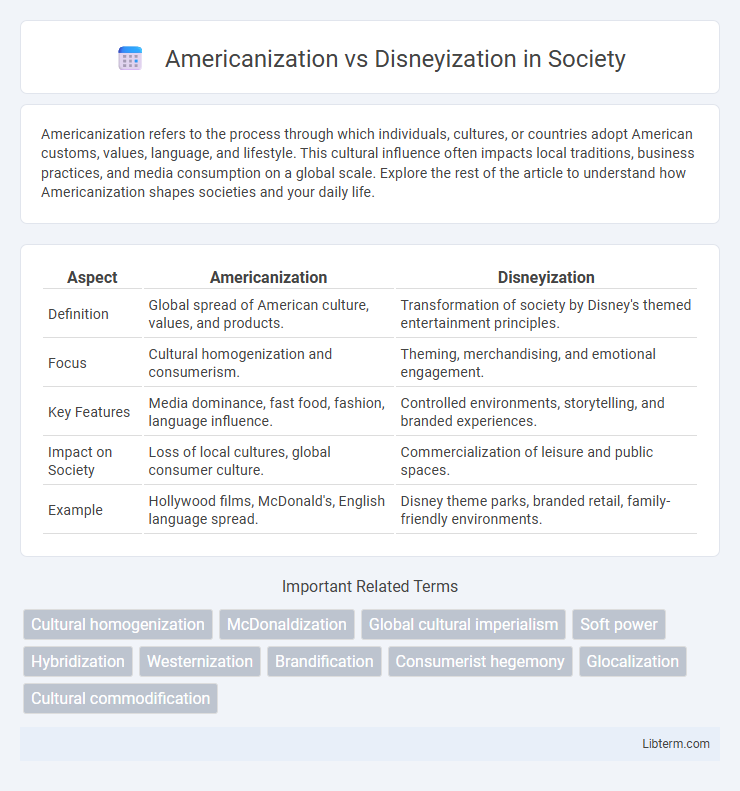Americanization refers to the process through which individuals, cultures, or countries adopt American customs, values, language, and lifestyle. This cultural influence often impacts local traditions, business practices, and media consumption on a global scale. Explore the rest of the article to understand how Americanization shapes societies and your daily life.
Table of Comparison
| Aspect | Americanization | Disneyization |
|---|---|---|
| Definition | Global spread of American culture, values, and products. | Transformation of society by Disney's themed entertainment principles. |
| Focus | Cultural homogenization and consumerism. | Theming, merchandising, and emotional engagement. |
| Key Features | Media dominance, fast food, fashion, language influence. | Controlled environments, storytelling, and branded experiences. |
| Impact on Society | Loss of local cultures, global consumer culture. | Commercialization of leisure and public spaces. |
| Example | Hollywood films, McDonald's, English language spread. | Disney theme parks, branded retail, family-friendly environments. |
Defining Americanization and Disneyization
Americanization refers to the global spread and adoption of American culture, values, products, and lifestyle, emphasizing consumerism, individualism, and popular culture. Disneyization involves the transformation of society through the principles of the Disney theme parks, characterized by theming, dedifferentiation of consumption, merchandising, and emotional labor. While Americanization centers on cultural dominance and influence, Disneyization highlights the commodification and experiential shaping of social spaces.
Historical Context: Origins and Evolution
Americanization emerged in the 20th century as the global influence of American culture, economy, and political ideals expanded through industrialization, media, and post-World War II economic dominance. Disneyization, a term coined by sociologist Alan Bryman in the late 1990s, refers to the process of transforming society and culture through the principles of the Disney theme parks, emphasizing theming, dedifferentiation of consumption, merchandising, and emotional labor. While Americanization reflects broad cultural diffusion rooted in political and economic power, Disneyization highlights a specific commercial and experiential cultural transformation shaped by entertainment and consumer culture.
Key Characteristics of Americanization
Americanization is characterized by the global spread of American culture, values, and consumer products, emphasizing individualism, innovation, and capitalism. It promotes English language dominance, fast food chains, entertainment industries such as Hollywood films, and the adoption of American lifestyles and business models. This process often leads to cultural homogenization, where local traditions and identities are influenced or overshadowed by American cultural norms.
Key Traits of Disneyization
Disneyization emphasizes four key traits: theming, where environments and products are designed around a central narrative; hybrid consumption, combining multiple types of consumption like retail, dining, and entertainment; merchandising, involving extensive sales of branded goods; and performative labor, where staff engage in role-playing to enhance customer experience. These elements create immersive, emotionally engaging settings that encourage prolonged visitor interaction and repeat visits. This process transforms spaces into controlled, predictable environments centered on family-friendly content and consumer satisfaction.
Cultural Impact and Global Influence
Americanization promotes the widespread adoption of American cultural elements, shaping local traditions and values through media, consumer brands, and lifestyle practices, which often leads to cultural homogenization. Disneyization, however, embeds entertainment-driven consumption patterns and themed environments into global cultures, emphasizing spectacle, theming, and merchandise, thereby transforming cultural experiences into commercialized, standardized attractions. Both phenomena significantly influence global cultures by reshaping identity expressions and consumption behaviors, but Americanization tends to emphasize cultural dominance while Disneyization prioritizes immersive consumer engagement.
Economic Drivers Behind Each Concept
Americanization drives global market expansion through the widespread adoption of U.S.-based consumer culture, emphasizing the export of mass media, fast food, and branded merchandise that generate substantial economic growth. Disneyization, characterized by the four dimensions of theming, hybrid consumption, merchandising, and performing labor, targets immersive consumer experiences that increase spending within entertainment and leisure industries. Both concepts leverage cultural commodification to stimulate global economic integration, but Americanization prioritizes standardization and scale, while Disneyization focuses on creating unique, emotionally engaging environments that maximize revenue per visitor.
Media, Entertainment, and Consumer Culture
Americanization drives global media by exporting U.S. television shows, films, and music, promoting cultural values rooted in individualism and consumerism. Disneyization transforms entertainment and consumer culture through themed environments, merchandise-driven experiences, and narrative branding, emphasizing imagination and family-friendly values. Both processes reshape global media landscapes but differ as Americanization spreads broad cultural norms while Disneyization creates immersive, corporatized consumption environments.
Criticisms and Controversies
Americanization faces criticism for cultural homogenization, where dominant U.S. values overshadow local traditions, leading to loss of cultural diversity. Disneyization draws controversy for monetizing culture through commodification, reducing authentic experiences to commercial spectacles. Both processes raise concerns over cultural imperialism and the erosion of indigenous identities amidst global consumer culture.
Comparative Analysis: Similarities and Differences
Americanization and Disneyization both involve the global spread of cultural values, but Americanization emphasizes the adoption of American social norms, consumer habits, and media influences, while Disneyization focuses on the commodification of culture through themed entertainment, branding, and immersive experiences. Both processes promote homogenization and commercialization; however, Americanization primarily affects lifestyle and ideology, whereas Disneyization transforms spaces through theming, dedifferentiation of consumption, merchandising, and emotional labor. The key difference lies in Americanization's broad sociocultural impact compared to Disneyization's concentration on experiential consumption and entertainment-driven globalization.
Future Trends: Global Culture and Identity
Future trends in global culture and identity reveal a dynamic interplay between Americanization and Disneyization, where American cultural values continue to spread through media and consumer products, reshaping local identities. Disneyization emphasizes themed environments, storytelling, and consumer experiences, influencing global entertainment and retail sectors by blending cultural narratives with commercial appeal. This convergence fosters hybrid cultural forms that challenge traditional identities while promoting a globalized sense of belonging driven by popular culture and immersive brand experiences.
Americanization Infographic

 libterm.com
libterm.com